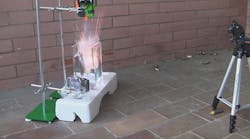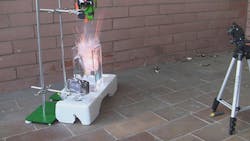These days talking about bombs will get you locked up or put on an NSA watch list. Back when I was in high school it could be a science fair project. These days you need a college degree to play with this stuff.
I remember my first experience with energetic chemical reactions in a science class. Our science teacher had a Plexiglass shield up and some white crystals, which turned out to be sugar, in a small beaker on a stand. He had another beaker with a liquid that was sulfuric acid. The reason for the shield, a hood, and a very long set of tongs was apparent when the liquid was poured into the other beaker. The result is a fiery, smoking, black snake that grows out of the beaker. Neat stuff.
We eventually graduated to dropping small amounts of soft, metallic potassium into water, H2O, dihydrogen monoxide. The reaction is a bit more spectacular requiring comparable precautions. In fact, being safe was one of the things I got out of watching these reactions in addition to an interest and love of science.
Lately some researchers at the Czech Academy of Sciences in Prague took a closer look at the pyrotechnic reaction (Fig. 1). They found that the original thoughts that the hydrogen produced by the reaction burned to cause the explosive reaction was not quite correct. (See “Coulomb explosion during the early stages of the reaction of alkali metals with âwater” for more details.)
The experiment uses a high-speed camera to record a reaction between water and a ball of sodium and potassium. The latter combination was used because it is liquid at room temperature. This allowed a syringe to emit a fixed-size ball that was spherical when it hit the water in a container below the syringe. This provides a reproducible experiment and that is what science is all about.
It turns out that the results vary depending upon the chemicals involved, so more experimentation is likely to occur. What they did find from the photographs were spikes that came from the surface of the sphere that accelerated at 10,000 m/s. The spikes even blossom with additional spikes.
Another part of the experiment was to replace the water with ammonia to change and slow down the reaction. The spikes still formed.
The effect of the spikes is key because it causes the two materials, like the potassium/sodium mixture and water, to remain in contact. Otherwise, the conversion to a hydroxide and hydrogen would place a barrier between the two to slow down the reaction. The researchers called the process a “Coulomb explosion.”
Hands-on science is sadly lacking in many schools these days, replaced by books and simulations. I heard a comment from one "supposed" science teacher that the students were not allowed to use the glassware for experiments because they would break it.
On the plus side, there are still enterprises like Estes Rockets that can still be used. I used them. My son and daughters did and I am hoping to build some with my grandson (only one grandchild so far) if he is interested.
Not every student would be able to replicate this experiment, but one might be surprised these days. I need to check out the applications for this year’s science fair (see “Mercer Science and Engineering Fair”) and see if anyone has tried.

